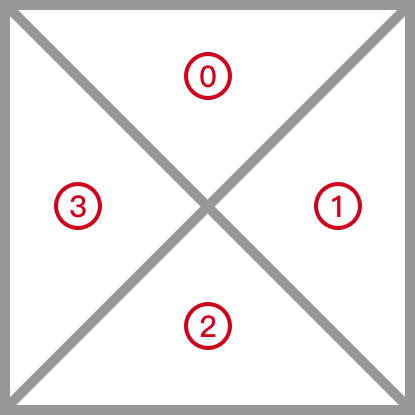959. Regions Cut By Slashes #
题目 #
In a N x N grid composed of 1 x 1 squares, each 1 x 1 square consists of a /, \, or blank space. These characters divide the square into contiguous regions.
(Note that backslash characters are escaped, so a \ is represented as "\\".)
Return the number of regions.
Example 1:
Input:
[
" /",
"/ "
]
Output: 2
Explanation: The 2x2 grid is as follows:

Example 2:
Input:
[
" /",
" "
]
Output: 1
Explanation: The 2x2 grid is as follows:

Example 3:
Input:
[
"\\/",
"/\\"
]
Output: 4
Explanation: (Recall that because \ characters are escaped, "\\/" refers to \/, and "/\\" refers to /\.)
The 2x2 grid is as follows:

Example 4:
Input:
[
"/\\",
"\\/"
]
Output: 5
Explanation: (Recall that because \ characters are escaped, "/\\" refers to /\, and "\\/" refers to \/.)
The 2x2 grid is as follows:

Example 5:
Input:
[
"//",
"/ "
]
Output: 3
Explanation: The 2x2 grid is as follows:

Note:
1 <= grid.length == grid[0].length <= 30grid[i][j]is either'/','\', or' '.
题目大意 #
在由 1 x 1 方格组成的 N x N 网格 grid 中,每个 1 x 1 方块由 /、\ 或空格构成。这些字符会将方块划分为一些共边的区域。(请注意,反斜杠字符是转义的,因此 \ 用 “\” 表示)返回区域的数目。
提示:
- 1 <= grid.length == grid[0].length <= 30
- grid[i][j] 是 ‘/'、''、或 ' ‘。
解题思路 #
- 给出一个字符串,代表的是
N x N正方形中切分的情况,有 2 种切分的情况'\'和'/',即从左上往右下切和从右上往左下切。问按照给出的切分方法,能把N x N正方形切成几部分? - 这一题解题思路是并查集。先将每个
1*1的正方形切分成下图的样子。分成 4 小块。然后按照题目给的切分图来合并各个小块。

- 遇到
'\\',就把第 0 块和第 1 块union()起来,第 2 块和第 3 块union()起来;遇到'/',就把第 0 块和第 3 块union()起来,第 2 块和第 1 块union()起来;遇到' ',就把第 0 块和第 1 块union()起来,第 2 块和第 1 块union()起来,第 2 块和第 3 块union()起来,即 4 块都union()起来;最后还需要记得上一行和下一行还需要union(),即本行的第 2 块和下一行的第 0 块union()起来;左边一列和右边一列也需要union()。即本列的第 1 块和右边一列的第 3 块union()起来。最后计算出集合总个数就是最终答案了。
代码 #
package leetcode
import (
"github.com/halfrost/leetcode-go/template"
)
func regionsBySlashes(grid []string) int {
size := len(grid)
uf := template.UnionFind{}
uf.Init(4 * size * size)
for i := 0; i < size; i++ {
for j := 0; j < size; j++ {
switch grid[i][j] {
case '\\':
uf.Union(getFaceIdx(size, i, j, 0), getFaceIdx(size, i, j, 1))
uf.Union(getFaceIdx(size, i, j, 2), getFaceIdx(size, i, j, 3))
case '/':
uf.Union(getFaceIdx(size, i, j, 0), getFaceIdx(size, i, j, 3))
uf.Union(getFaceIdx(size, i, j, 2), getFaceIdx(size, i, j, 1))
case ' ':
uf.Union(getFaceIdx(size, i, j, 0), getFaceIdx(size, i, j, 1))
uf.Union(getFaceIdx(size, i, j, 2), getFaceIdx(size, i, j, 1))
uf.Union(getFaceIdx(size, i, j, 2), getFaceIdx(size, i, j, 3))
}
if i < size-1 {
uf.Union(getFaceIdx(size, i, j, 2), getFaceIdx(size, i+1, j, 0))
}
if j < size-1 {
uf.Union(getFaceIdx(size, i, j, 1), getFaceIdx(size, i, j+1, 3))
}
}
}
count := 0
for i := 0; i < 4*size*size; i++ {
if uf.Find(i) == i {
count++
}
}
return count
}
func getFaceIdx(size, i, j, k int) int {
return 4*(i*size+j) + k
}